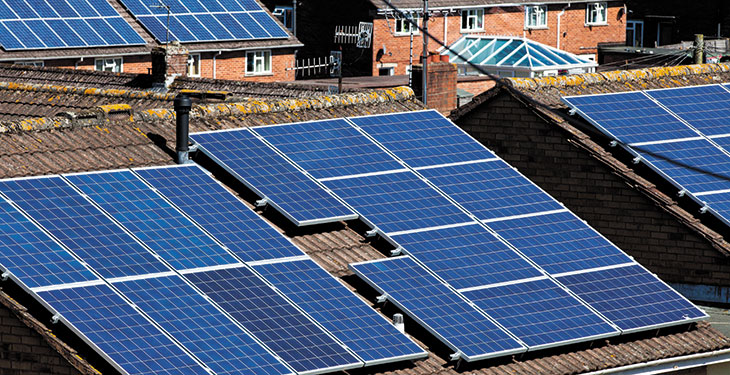We are noticing a trend that sticks, although the direct support from the Romanian state remains disappointingly limited. The number of power producers from photovoltaic sources has increased strongly in the past few years, despite the still too bureaucratic regulations, little encouraging remuneration and dysfunctional support scheme.
We summed up the connection contracts issued by Transelectrica for production points from PV sources of less than 10 kW and obtained an updated picture of the distributed power generation market in this sector. At the end of April 2021, there were about 9,400 small solar power producers. They account for over 92% of total generation units from photovoltaic sources connected – 10,194, according to Transelectrica data.
The share of small producers is considerably greater in the photovoltaic segment, compared to the situation in the wind power generation market, where units smaller than 10 kW account for only 4.8% of the total.
Geographical distribution of small producers shows that 2,090 of them are in the operation area of Distribuție Energie Oltenia (formerly CEZ). Over 1,300 are found in the operation area of E-Distribuție Muntenia SA (formerly Enel Distribuție Muntenia) (1,373) and in the operation area of Delgaz Grid SA (formerly E.ON Moldova) (1,302). The smallest numbers are found in Dobrogea (operator: E-Distribuție Dobrogea SA, formerly Enel Distribuție Dobrogea) – 575 and in the Muntenia Nord region (operator: SDEE Muntenia Nord SA, formerly Electrica Muntenia Nord) – 819.
In total, the total installed capacity in small units is close to 130 MW, still insignificant at national level. However, these figures can give us an idea about the total contribution of distributed generation in the following years, if this trend is maintained or accelerated. The large differences between the total installed capacities in the 7 regions draw our attention. With 2,090 small producers, Oltenia totals 61 MW, while Banat totals 41 MW from only 1,165 small producers. At the opposite side, 1,302 connected units in Moldavia mean an installed capacity of only 4 MW; we find comparable figures in Transylvania, while Dobrogea, the smallest region by area, with only 575 small producers of photovoltaic plants, has in total less than 2 MW.
It should be stressed that the largest part of connection contracts was concluded in the last 12-18 months. With all the inefficiency, blockages and confusion in the market, the AFM program for supporting small distributed PV power generation has achieved at least one goal – it has provoked emulation and aroused the interest of a significant number of small investors interested to contribute at least partially to the generation of the electricity they use.
Greenpeace Romania has strongly criticized the fact that “less than 1,000 photovoltaic systems” were financed through the program of the Environment Fund Administration (AFM). Of the 26,000 files registered, over 10,000 were ‘erroneously’ rejected, Greenpeace believes.
PATRES WILL ALSO BE THE ORGANIZATION OF PROSUMERS
Starting with 2018, important steps have been taken to support prosumers, notices Viorel Lefter, PATRES President, in a press release in which he announces that the Renewable Energy Producers Organization in Romania (PATRES) will also be the Organization of prosumers.
The measures with a significant favorable impact include “allowing grid injection, eliminating the building permit, eliminating the income tax and the obligation to become a self-employed, partial simplification of connection procedures, the opening of AFM programs “Casa Verde” and “Electric-Up”. These two programs still have a great potential of contributing to the development of prosuming in Romania, as, with all the delays, numerous potential beneficiaries are expected.
In his turn, Martin Moise, Senior Vice President of PATRES, complains that “some distribution operators still put obstacles and unjustifiably delay the connection of prosumers”. Therefore, Martin Moise announces as priority actions to support prosumers “simplification and acceleration of connection procedures, […] extension and simplification of AFM programs “Casa Verde” and “Electric-Up”, enforcement of law 101/2020 and […] revision of the regulated price for grid injection, a price currently entirely unattractive from an economic point of view”.
Greenpeace also complained about this last shortcoming, finding that, at the moment, the price regulated by law offered to prosumers for energy delivered into the grid is RON 0.19, i.e. 3 or even 4 times lower than the purchase price from the supplier. “But the investment is disadvantageous and discouraging, precisely due to this large price discrepancy. On average, amortization of a photovoltaic system, without the financial support from AFM (which has reached only an insignificant number of citizens) takes approximately 15 years”, finds Marian Mândru, campaign coordinator at Greenpeace Romania.
PROMISE STILL UNFULFILLED
To stimulate the injection of green energy into the grid, the authorities have invoked the possibility of introducing in the legislation of a form of quantitative compensation, through which the prosumer would “get back” the energy delivered into the national distribution system, when needed. “Basically, through this measure, the government would value more the energy produced by citizens, equaling it to the price they pay when they buy energy from the supplier”, explains Marian Mândru.
—————————————-
This article first appeared in the printed edition of Energynomics Magazine, issued in June 2021.
In order to receive the printed or electronic version of this issue of Energynomics Magazine, we encourage you to write us at office [at] energynomics.ro to include you in our distribution list. All previous editions are available HERE.
